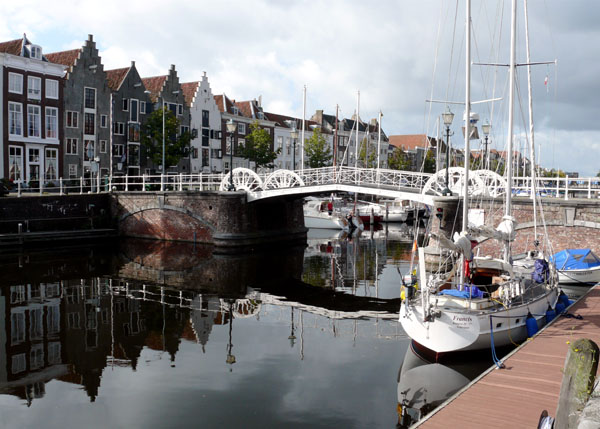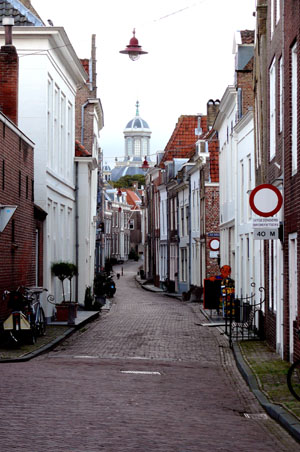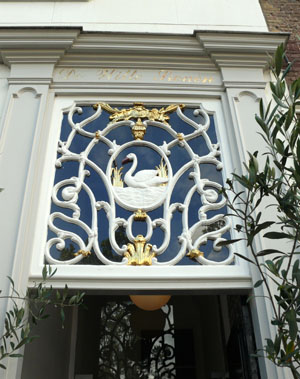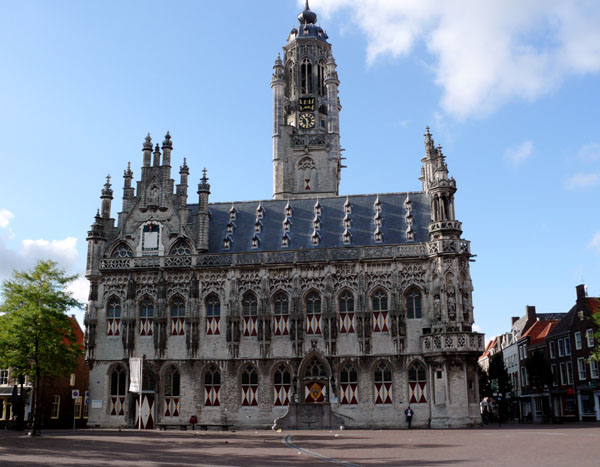MIDDELBURG, THE NETHERLANDS- I’m such a pushover for small Dutch cities and towns. I fall in love with them so quickly.
And why not? They’re all so lovely; so neatly kept; so postcard perfect.
I especially love their squares, which are almost always surrounded by quaint cafes, grand churches and important monuments - so different from anything we find in North America.
Love their gable homes, with the charming gardens, painted shutters and window decorations.
Really love their cheese and bake shops, which lure me inside with delightful scents and colourful window displays that make me want to sample everything.
Which probably explains why I really love Zeeland, the southern-most province in the Netherlands which seems to have an abundance of picturesque places like Middelburg, its capital.

Above: Middleburg's harbour was once second only to Amsterdam’s in importance.
A medieval city, whose harbour was once second only to Amsterdam’s in importance and activity, Middelburg has evolved into a peaceful hamlet where people come to settle in their later years and tourists come to soak up its history and ambience.
In my case, it’s love at first sight as I turn a corner in my Fiat 500 rental car and find myself in Dam Plein, one of Middelburg’s many attractive squares. It’s surrounded by lots of architectural eye candy, including the handsome Hotel aan de Dam, the property where I’ve booked a room for the night. The hotel is housed in a 17th century building officially known as the d’Oude Meulen, built by Jacob van Campen in 1652. And it stands right next door to the city’s oldest house, a black and white-painted beauty showcasing its original wood siding that was erected in the early part of the 15th century.
Being midday, the hotel receptionist suggests I walk to nearby Markt (market) Plein (square) and enjoy a meal at one of the charming cafes that ring this town’s favourite gathering spot. She suggests a restaurant named De Vriendschap, where I’m introduced to locally caught muscles that come swimming in a sweet broth, followed by a platter of shaved veal and Dutch cheeses.
As I sip my glass of wine and admire the sun bouncing off the golden crown that sits atop Middelburg’s gorgeous 13th century abbey, I’m distracted by the sound of bells. The chiming is coming from Middelburg’s cathedral-like City Hall, which dominates Markt Plein. Each time the clock strikes the half hour, golden figures on the bell tower emerge and start battling each other with spears.
A local woman sitting nearby sees my bewilderment and offers an explanation.
“The figures represent a famous battle that was fought here,” says the woman who identifies herself as Ina.
Ina then tells me the City Hall dates back to the 15th century – built between 1452 and 1458 – and it’s one of the 1,200 monuments scattered around this compact city which once served as a Roman fortress.
Intrigued, I ask Ina to tell me more about enchanting Middelburg, which has become an important centre for the arts in the Netherlands.


Above: Spanish Street is one of the city's oldest and homeowners decorate their homes nicely.
“If you have time, I will show you around town – it’s much better to see what I’m describing,” says Ina.
I jump at the chance and soon Ina and I are walking through an impressive 16th century stone gatehouse with an effigy of Prince William of Orange II carved into it. The gate, which Ina says is called a “gistpoort or blanwepoort or ankerpoort – all three words mean the same in Dutch,” leads to Abbey Square where the great church and several museums, including Zeeland’s Museum of History, which contains some very precious Flemish tapestries, are located.
Just before reaching the front door of the 13th century abbey, Ina draws my attention to a small stone statue with a rider on horseback holding a spear in one hand.
“Do you know what that represents?” Ina asks, of the statue that sits off to one corner of the square. My silence tells her I don’t.
“The rider is playing riring, and it’s a very big sport here in Zeeland – and women are the best players,” boasts athletic-looking Ina of the Dutch version of polo in which the rider on horseback tries to spear a donut-sized ring that keeps getting smaller as the competition progresses.
Ina then directs my attention skyward – to the top of the abbey’s great spire which stretches 90 metres above the town.
“We call the spire Tall John,” says Ina, who reveals that the crown which sits atop the impressive structure is a gigantic replica of the regal headdress once worn by Prince William II.
“You may notice Tall John leans just a bit to the right – the soil here is very soft,” explains Ina.
Tall John is lucky to still be standing at all, because Middelburg suffered extensive bombing during World War II – the Nazis were trying to flush out French troops stationed here – and many of the city’s historic buildings suffered damage, but thankfully none were totally destroyed.
Workmen buzz around us in Abbey Square, placing chairs for a scheduled concert – one of many held throughout the summer months in this town of about 48,000 citizens.
Ina then insists I follow her to the oldest street in Middelburg, Spanish Street, which sits directly behind Abbey Square and leads to another of Middelburg’s impressive buildings, the centuries-old East Church, a Baroque-style beauty with a domed roof.
Spanish Street is among Middelburg’s 1,200 monuments – “yes, we even regard streets here as monuments,” Ina tells me – and it’s the oldest street in town, dating back to the 13th century,
A handsome collection of townhomes lines both sides of narrow Spanish Street and most of the doors are painted with a glossy dark green paint which Ina says was specifically created for the homes here. Above each door is a lavish decoration called a horren, and behind each house, hidden by red brick walls, are beautiful gardens.
“These homes are very expensive and Spanish Street is a very desirable address now – but it wasn’t always that way,” says Ina about a thoroughfare frequented by prostitutes and lonely sailors back when this was a thriving port in ancient times.
Another of Middelburg’s great churches comes into view as we exit Spanish Street - the 15th century Choir Church, which houses the oldest organ in the Netherlands.
We circle back to Dam Square and on the north side Ina points to what’s left of Middelburg’s once impressive harbour, where ships of the East and West India Trading companies once unloaded their precious cargo from far off lands in Asia. Just a tiny channel now remains, but there’s still lots of boats lining both sides of it – Middelburg, it appears, has become a favourite with today’s yachting set.
Along Kuiperspoort Street, which runs parallel to the channel, Ina tells me No. 50 is where Zeeland’s governor now lives. And in an alleyway just off Kuiperspoort, Ana points to some trendy red brick apartments that once served as warehouses for the East and West India companies.

Above: Middleburg's ancient City Hall and main square are very impressive.
A lovely white iron drawbridge from the 18th century allows us to cross the channel and reach the Spijkerbrug, another street where we find more warehouses converted into lovely apartments. Some have drawings of camels, elephants and donkeys etched on them. One of the refurbished warehouses is called the Kinderjyk and it leans very much to the right.
“The workers in the early days of Middelburg painted the animals on the warehouses because they represent hard work,” says Ina, who then lowers her eyes as we come upon a huge chunk of marble with one corner painted black.
“That is our slavery monument and it represents the darkest time in Middelburg – when the East and West India companies brought slaves here from Africa before they were dispatched to America. Those companies became very rich - literally on the backs of others,” says Ina, whose spirits are lifted again by the sight of the town’s old shipyard.
“Besides being a great port, we also made great ships in Middelburg back in the 17th century. In all, 365 sea-worthy ships were built here.”
We arrive back in Markt Square just as the merchants are packing up their wares after a long day of selling. The sun is just starting to dip behind the red clay roofs that dominate the skyline here and the cafes are beginning to fill up with people enjoying a late afternoon drink.
Over a coffee and some stroopwafels – biscuit-like waffles with a sweet caramel filling – Ina says she wishes more North Americans would visit her town because “we love sharing our story with strangers.”
There’s a lot of love in the air in Zeeland.